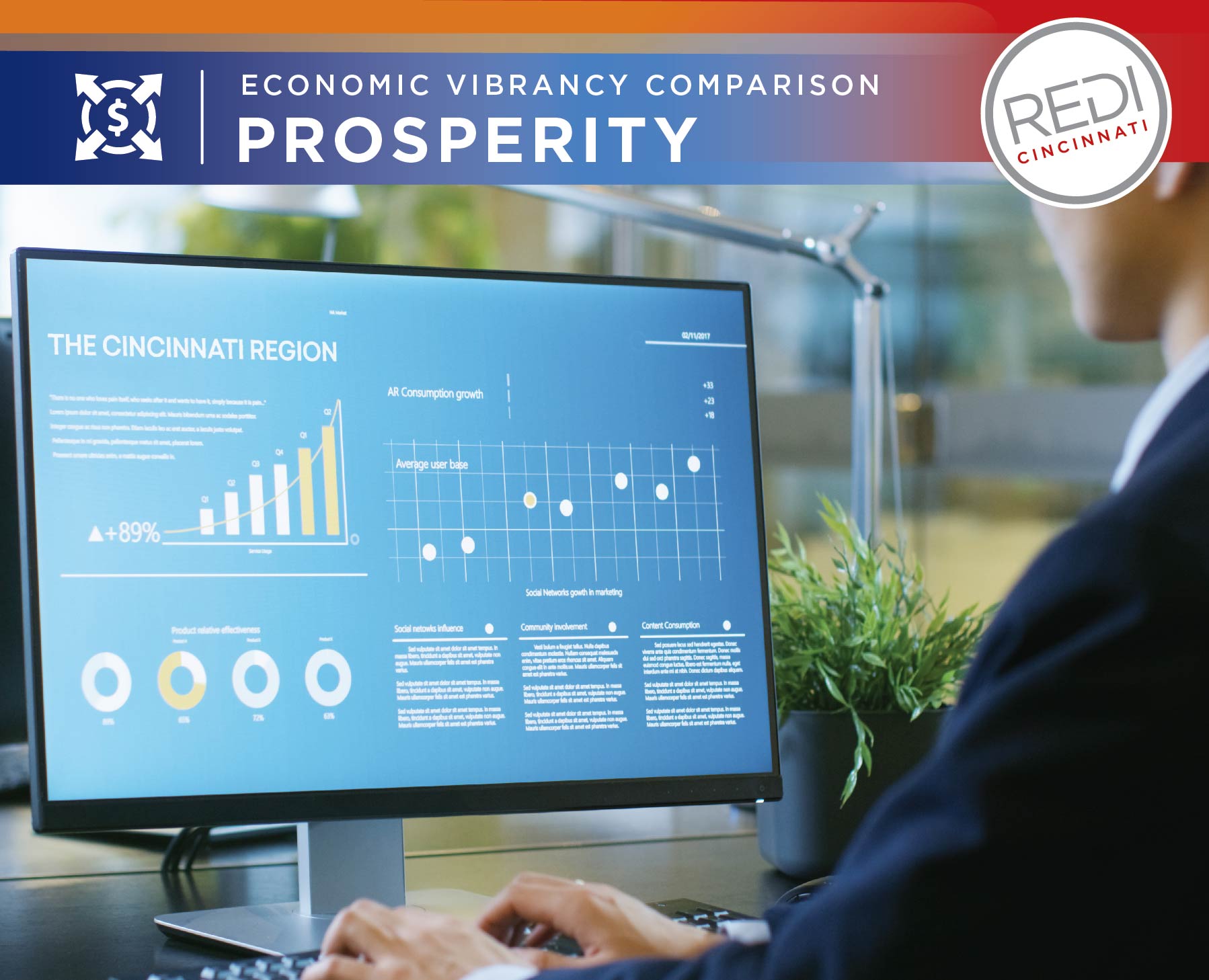Economic Vibrancy Comparison/Report: Prosperity

This is the final part of a six-part series examining an economic comparison report led by REDI Cincinnati’s research team. The comparison benchmarked Cincinnati in six strategic areas—growth, talent, innovation, housing, prosperity, and inclusivity—against 39 peer MSAs ranging from 1-4.5 million people. In this edition, we’ll take a look at Prosperity.
Read the series:
- Growth with Job Growth Comparison Deep Dive
- Housing
- Innovation
- Inclusivity
- Talent
- Prosperity
Please note that each of the areas examined in this blog series considers data from different time periods. The data used in this report is made publicly available at both different points in time and at varying intervals. For transparency, the time frames are noted in parentheses in each sections’ headline.
Prosperity
In the past five blog entries in this series, we explored a wide range of socioeconomic data collected about Cincinnati and 39 comparison regions. But perhaps we shouldn’t consider prosperity as another in this series so much as the culmination of everything we’ve looked at so far. Because a prosperous region is a growing region, with housing for all and an abundance of innovation for a strong, diverse talent base that offers boundless opportunity for all the region’s residents.
Prosperity is more than just economic data on a graph, though we do have insightful comparison data that helps us understand both where we shine and some of the challenges ahead for our region. There are numerous factors we should consider about Cincinnati living, beyond financial information like wage growth and median household income, that create a comprehensive (and distinctly positive) picture of Cincinnati’s uniquely prosperous personality.
Cincinnati’s Prosperity Data, by the Numbers (Data points in report from 2022)
According to the data metrics we collected for our comparison report, Cincinnati ranks around the middle of the pack with a median household income of around $67,000. For comparison, San Jose led the metric with a median household income of nearly $131k, while Memphis’s average of $55k per household sat at the bottom.
Furthermore, Cincinnati’s average annual wages in 2020 sat at just shy of $60k, with an increase of 7.6 percent from the year prior. (Most other regions, we should note, grew at a slightly higher rate.) And the five years prior to 2020 saw a 14 (top 10 percent of wage earners) to 15 (bottom 10 percent of wage earners) percent increase in wages. While these numbers show that Cincinnati’s financial prosperity is increasing, the comparison data reveals that our region still has some work to do to improve our positioning. Our per capita income and annual wages, while increasing, both did so at a rate that puts us right in the middle of all examined MSAs.
And there’s no discussing prosperity without also taking a look at poverty, an area in which Cincinnati can improve. In 2019, approximately 11 percent of our region’s residents lived in poverty, which the federal government sets at a household income of $26,500 for a family of four. (This translates to a wage of around $12.75 an hour.) Nearly 63 percent of all jobs in our region pay above this poverty level—a lower percentage than most of the regions examined. And while we have seen poverty rates decline by almost 19 percent between 2014 to 2019, our region’s rate of decline falls below that of slightly more than half the regions we examined.
So, the data tells us that, while our region is certainly doing better than we were in recent history, around half of the MSAs we looked at are currently outperforming us. But, looking beyond the financial data, we get a much more positive outlook for our city’s prosperity.
Prosperity Beyond Financial Reporting (Data points in report from 2022)
One factor that our by-the-numbers data report doesn’t account for when detailing income and poverty data is cost of living—and Cincinnati residents enjoy a notably low cost of living. In fact, in 2019 the Bureau of Economic Analysis named ours as the lowest cost of living among major metros.
This is critical companion information to our financial reporting, of course, as everyone knows a dollar in Cincinnati goes a lot further than it does in Silicon Valley, for example. In our previous post on Housing, we established that Cincinnati is close to the top 25 percent of examined regions for single-family home price affordability with an average purchase price of $220,000. And our region is fourth-lowest for median rental costs among all the examined benchmark regions, too. So, residents can live here affordably, which is part of why Business Facilities recently named our city among its top 10 (No. 7) “Most Affordable Cities.” But beyond cost-of-living essentials such as housing and groceries, there’s also just a whole lot to do here that won’t drain the bank account, making Cincinnati a great place for affordable quality of life.
With four professional sports teams (Reds, Bengals, FC Cincinnati and Cyclones), Cincinnatians always have an opportunity to take in a game and cheer with fellow fans. We have tons of regional arts and education organizations like Cincinnati Opera, Playhouse in the Park and The Cincinnati Art Museum (the latter featuring free admission, to boot) to engage the senses, and world-class events such as BLINK and Taste of Cincinnati make going out on the town a thrilling experience.
Cincinnati’s Great Parks is a notable jewel in the Queen City’s crown. With more than 115,000 acres of protected green space and 365 parks recognized by the Trust for Public Land (who recently ranked ours the 6th best out of 100 park systems nationally), our region offers plenty of opportunities to power down and connect with nature.
In short, you live well for less in Cincinnati. And as our region continues to improve in terms of line-item financial data, we already know Cincinnati’s prosperity, high quality of life and richness of heart make this the place to live, work and play.
